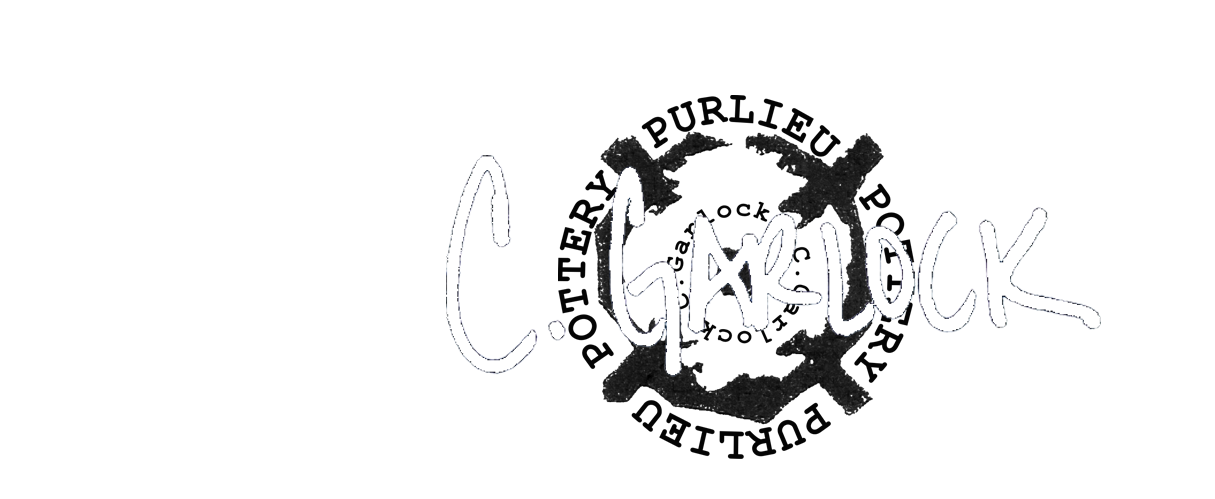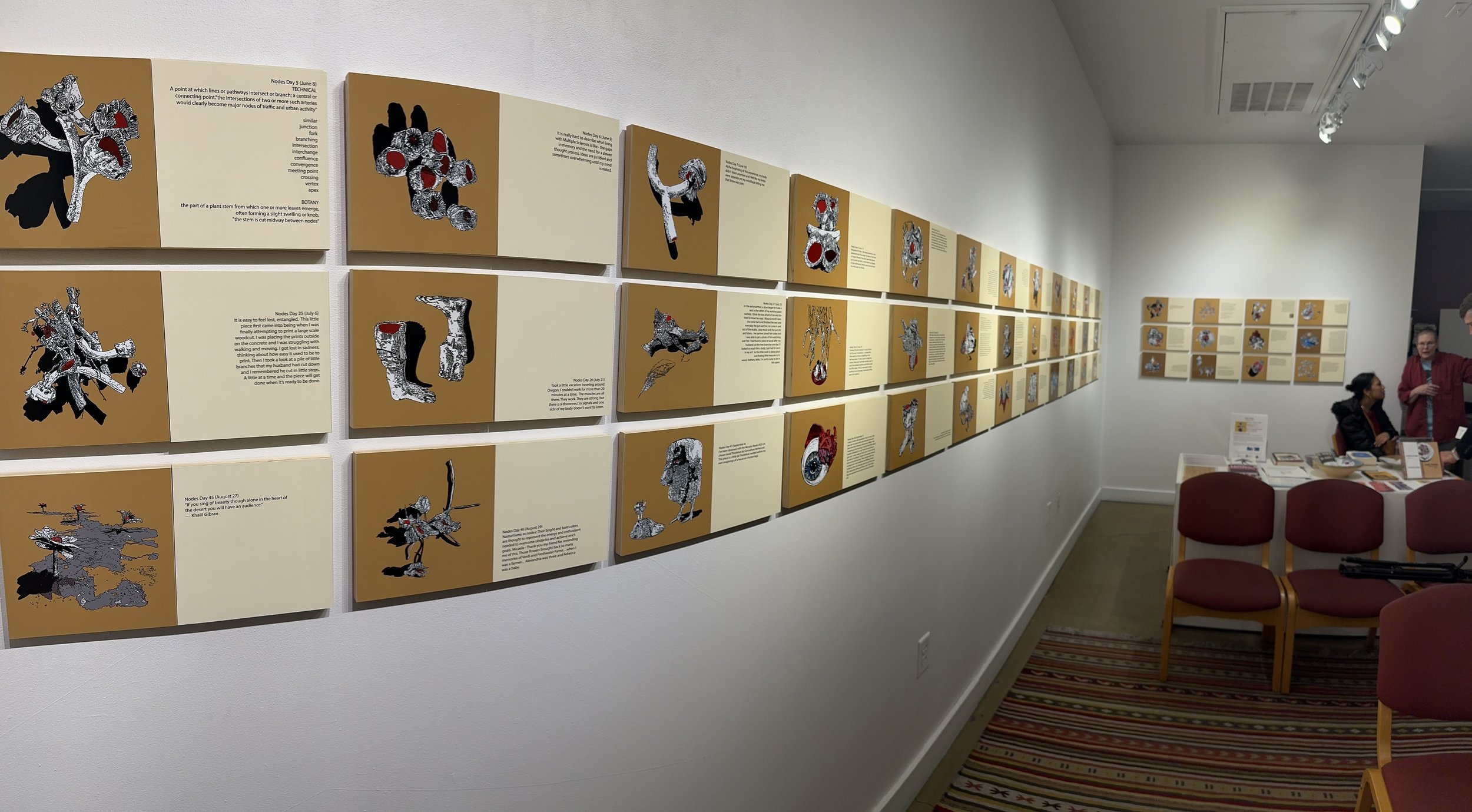Into the Realm of a Body Rewired
“Citizen of That Other Space” – Savage Mystic Gallery, Reno, NV, Dec. 3 – 28, 2024, By Mark Maynard
Candace Garlock’s work has long challenged assumptions. To some, it may even present taboos and break norms. In earlier work, she challenged the male gaze that has informed art for centuries by focusing on the male body, objectifying the form and unsettling viewers that have grown accustomed to associating the feminine as a definition of beauty.
Her prints and sculpture often exist in an uncanny space where realistic forms can be discerned, but only through a haze of layers, juxtapositions of human and animal forms, and repeating shapes found in nature: honeycombs, limbs, beaks, and circles. Vibrant colors exist in Garlock’s palette, but many of her surfaces are blacks, browns and greys where hints of blue, yellow, and blood red draw the eye toward shapes and parts: cyan-toned eyes, red feet, and creamy-yellow yolks and beaks.
Motifs resurface across Garlock’s work in subtle ways, and evolve in both scale and meaning. Human feet sometimes descend from the round bodies of strange birds, or attach without joints to the bottom of a spiky pangolin. Circles and hexagons become tiny canvases that can be infinitely linked together, inviting the collaboration of other artists through forms that are easily shared. Wood discs can be sent via mail to a collaborator, each tiny part adding meaning and frisson to an unplanned mosaic, a constellation of individual works, or a beehive built by hardworking drones to achieve a larger collective purpose.
Nevada Humanities Program Gallery 2024
Installation view from street, Savage Mystic Gallery, Photo taken by Brandon Lacow.
Her latest exhibition is her most deeply personal, and Garlock herself becomes incredibly vulnerable, confronting the viewer to join her on a journey within a body whose modes of communication are slowly breaking down.
Garlock and I are colleagues at Truckee Meadows Community College, and a little over a year ago, in discussions about art and expression, we found we had another common bond. My maternal grandfather had Multiple Sclerosis (MS), the same disease Garlock was diagnosed with in 2011. For my grandfather, the charming pater familias of five kids, MS altered his life dramatically. Once a multi-sport athlete – golf was his passion, and he played at a near-professional level – he ended up needing a wheelchair and eventually lived out his days bedridden in a convalescent home. The disease affects the communication between brain and body, leading to both physical and neurological symptoms. This creates dual challenges for a visual artist who must conceive and hold inner expressions and then create them physically on canvas, in sculpture, and in the arrangement of her individual pieces to create a larger meaning.
Garlock invited me to experience her most recent show “Citizens of that Other Space” as it was installed the Savage Mystic Gallery in Reno, NV in December, 2024.
Not only are the individual pieces of the exhibit – a multimedia presentation of ceramic sculpture, woodcut prints on natural papers, and pieces of Garlock’s painting and photographic work – wholly original, but its arrangement subverts the expectations and layout of a traditional art gallery. This is not an avant garde statement so much as it approximates for the visitor what the altered communication signals between eye, brain, and body might be for the artist.
Citizens of that Other Space installation, photo taken by Brandon Lacow
Where works are often arranged at eye level along a gallery’s walls, Garlock uses the main vertical surface of the gallery to mount industrial plumbing fixtures. From the downturned mouths of seven metallic spigots ooze printed scarf-sized pieces of fabric. Within the lines of black-and-white prints are splashes of blood red. Below each spigot is mounted a semi-circular shelf of clear acrylic supported by its own industrial pipe, and on each shelf, pairs of disembodied bare human feet, cut off mid-calf and cupped, each a vessel filled with orange or red gel, giving the appearance of a visceral, sanguine fluid
Installation Photo taken by Brandon Lacow
While light is often used in galleries to highlight and soften the work, in Garlock’s space, unfiltered industrial bulbs are hidden at floor level under an asymmetrical coffee table, casting their low-angled light on more sets of feet between white boxes which are themselves platforms supporting ceramic flowering plants. Both the feet and plants are cast in intense light creating sharp shadows on the floor and the wall behind. In the center of the cupped flowers, more of the red and orange gel, its sheen and opacity deceiving the viewer into believing it is in liquid form. The female organs of the flowers are canted at impossible angles, the nectar never spilling over the top of the vessels, suspended in state of arrested animation that creates a sense of vertigo and imbalance for the viewer, unable to find a defined horizon of tabletop or floor.
Atop the coffee table a serpentine, zig-zagging mirror reflects black and white prints off the surface. At one end of the mirrors, a close-in photograph of hirsute human skin appears to be pierced by the hooked fangs of tattooed ants. On the surface of the mirrors are images of splayed child-like hands, the finger tips pierced with fish hooks.
Relapse/Remission, Folding Book made from Plexi, digital prints, mirrors. Photograph by Brandon Lacow
Another expected characteristic of a gallery – an unobstructed eyeline of the works from any part of the space – is subverted by the third main element of the exhibit. Here, suspended from the high ceiling of the gallery, are massive identical woodcut prints on natural fiber paper. These are clearly trees, cloned, inverted and hanging from the ceiling where they obstruct clean views of the work from any point in the gallery, forcing visitors to walk through a labyrinth of inverted artwork, further complicated by the presence on the floor of several pair of disembodied feet. These are life casts of the artists’ own, mounted on cylindrical bases and haphazardly placed among the upside-down forest.
Never Out of the Woods Installation Photo by Brandon Lacow
It is in this unsettling tableau that the viewer can empathize with the artist’s changing mind and body. Multiple Sclerosis is a disease of fractured bodily communication, a chronic condition that Garlock says is best represented by the metaphor of the tree-like prints, never being “out of the woods” of the disease’s inexorable grasp. The disembodied feet, each a vessel for a liquid that looks sometimes bloodlike, sometimes like a strange nectar, represent that reality that Garlock’s own are functional, yet often lost in a sensory shadow where she cannot feel them, and thus must often watch her own feet walk in order to make sure they are placed where she intends. It is this downcast view the artist uses to show us the beauty in the detritus of the sidewalk and the duff of the forest floor: hearts, leaves, petals, and the intricate patterns of moth and butterfly wings.
Close up image of the feet below the “forest” prints. Photo by Brandon Lacow
The artist uses the exhibit spaces to let the viewer experience the place as she might. When her work appeared at the Lily Museum, the ceramic feet were placed on the gallery’s staircase, blocking visitors from moving up to the second level as Garlock’s own feet prevented her from accessing that part of the space. At the Savage Mystic Gallery, those same feet were tucked into dark corners hidden behind the shadows of hard-edged platforms.
Lilly Museum of Art Installation and Savage Mystic Gallery Installation of the little feet.
Even for the humblest of artists, an exhibition of their work is an extension of life, a way to influence and be seen even after death. What creates tension with Garlock’s work within this context, is that it is also very much about her body rebelling against itself in ways that are often invisible to all but the artist herself (and those medical technicians and practitioners that capture images of the nodes and lesions in her brain, internal prints that mirror the roots, flowers, and branches of her upside-down trees). It is this process that she invites her viewers into with her.
The experience is powerful and while the moments of confusion and pain (the fishhooks in the small fingers pulled taut by thin lines and the probing fangs of the ants piercing skin particularly evoke neuropathic discomfort) can feel overwhelming in parts of the space, they are tempered by the strange beauty of the natural shapes of the objects, and darkness is overpowered by hope and humor. Ultimately, the installation is not about loss, but perseverance, and the adaptation of the artist’s skills to a new reality in the ways she interacts with familiar themes and mediums. In some ways, it harkens back to Garlock’s groundbreaking efforts to divest visual art from a purely male gaze and ask those interacting with the work to reconsider their own biases and assumptions, particularly centered on the invisibility of chronic autoimmune illnesses, and the way they are perceived, particularly when women are the patients.
Through this work, the artist makes her vulnerability an invitation to the viewer. Not only does the installation stimulate and confuse the senses to evoke the sense of a dysfunctional communication network, but it also confronts the viewer with their own humanity – an inevitable breakdown of the body and mind, and what is important to be seen and valued in all the remaining days we have to appreciate beauty, connection, and worlds both internal and external.
Mark Maynard is a freelance writer and documentary filmmaker. He wrote and directed the 2023 documentary film "Piconland: The Quest for the Perfect Picon Punch" that played numerous festivals including the Austin Revolution Film Festival, Cinema on the Bayou Film Festival, and the Dam Short Film Festival where it won "Best Nevada Film" in 2023.
In 2015, Maynard received the Silver Pen Award from the Nevada Writers Hall of Fame, and Grind was selected the 2016-17 Nevada Reads Book by the Nevada State Library and Nevada Center for the Book. He was the winner of the first ever Literary Death Match to be held in the Biggest Little City in the World. Maynard teaches English, journalism and creative writing at Truckee Meadows Community College and lives in Reno, NV with his wife and children.









